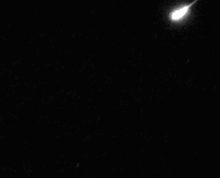
Oil painting by Frederic Edwin Church, The 1860 Great Meteor
A meteor procession occurs when an Earth-grazing meteor breaks apart, and the fragments travel across the sky in the same path. According to physicist Donald Olson, only four occurrences are known:[1]
- 18 August 1783 Great Meteor[1][2]
- 20 July 1860 Great Meteor; believed by Olson to be the event referred to in Walt Whitman's poem Year of Meteors, 1859–60[3][4]
- 21 December 1876 Great Meteor; sighted over Kansas, Missouri, Illinois, Indiana, Ohio, Pennsylvania[5]
- 9 February 1913 Great Meteor Procession; a chain of slow, large meteors moving from northwest to southeast, sighted over North America, particularly in Canada, the North Atlantic and the Tropical South Atlantic
See also
References
- 1 2 Falk, Dan (1 June 2010). "Forensic astronomer solves Walt Whitman mystery: CultureLab (blog)". New Scientist. Archived from the original on 21 March 2016. Retrieved 8 February 2023.
- ↑ "Notes and Queries". Journal of the Royal Astronomical Society of Canada. 8: 221–222. June 1914. Bibcode:1914JRASC...8..221. Retrieved 8 February 2023.
- ↑ "Forensic astronomer solves Walt Whitman mystery". New Scientist. 1 June 2010. Retrieved 8 February 2023.
- ↑ "150-year-old meteor mystery solved". MSNBC. 2 June 2010. Archived from the original on 5 June 2010. Retrieved 8 February 2023.
- ↑ Herschel, Alexander Stewart (1878). "Observations of luminous meteors". Report of the forty-seventh meeting of the British Association for the Advancement of Science: Held at Plymouth in August 1877. John Murray. pp. 149–153.
External links
This article is issued from Wikipedia. The text is licensed under Creative Commons - Attribution - Sharealike. Additional terms may apply for the media files.
